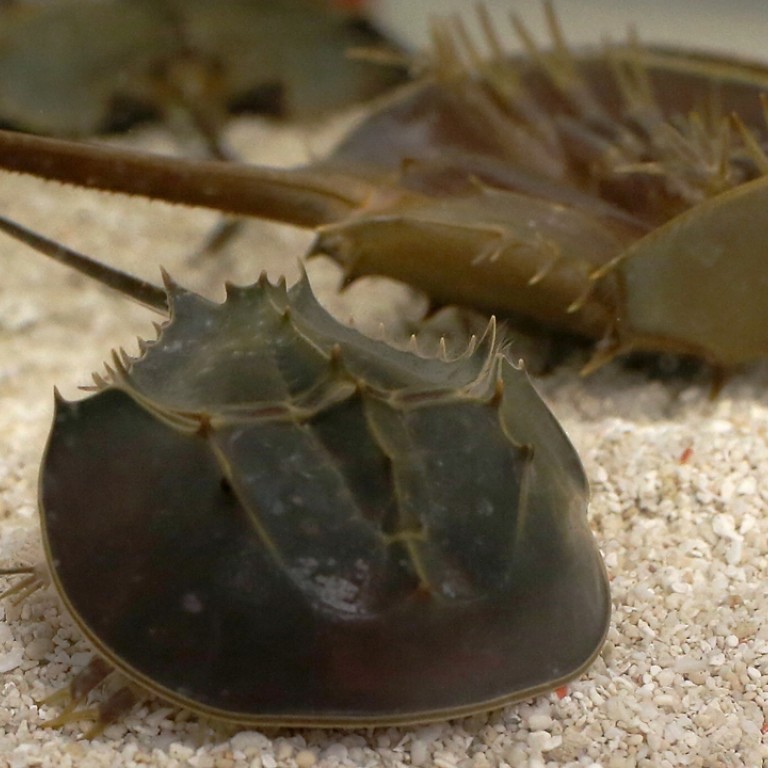
Killing horseshoe crabs for good karma? Misguided Hong Kong Buddhists send pre-dinosaur species to their death, say conservationists
Aquatic ecology experts warn that releasing the creatures into the wild as part of a Buddhist ceremony may endanger the species
Horseshoe crabs, an ancient marine creature that outlived dinosaurs, are coming under threat from religious groups who believe they are saving them by releasing them back into the sea.
The centuries-old Buddhist practice is based on the belief that humans can be reincarnated in any animal form. By releasing seafood such as crabs, fish and clams back into the sea, Buddhists believe they are creating good karma by saving them from ending up on people’s dinner plates.
READ MORE: Horseshoe crab ‘will disappear without funding’
But the chances of horseshoe crabs surviving the ordeal are slim, especially if they are released near piers where the water is more polluted and they fail to adapt to a new environment.
“They think they are letting them live, but actually they’re sending them off to die,” said Professor Kenneth Leung Mei-yee, who is an expert in aquatic ecology at the University of Hong Kong.
The creature, often intentionally caught by fisherman to sell to religious groups, can only survive on muddy shores as juveniles or in waters close to their natural spawning site as adults.
Hong Kong Release Live, a Buddhist group that organises such activities at Tsuen Wan pier, claims they have saved 140 million lives in the three years since they began operating.
Once a week, a group of 20 to 30 people board a boat filled with buckets of seafood bought fresh from the wet market in the morning. A Buddhist monk then chants his blessing before people take turns to tip the buckets into the sea.
The seafood offerings are funded with donations, which can reach up to HK$10,000 per trip, according to the group’s coordinator, Rosa Chan.
Chan admitted to releasing horseshoe crabs on several occasions. “You should thank us for releasing them back in the wild. Nobody will eat them and the fishermen are just earning money off of us,” said Chan.
READ MORE: Saving the crab that saves lives
Referring to their latest photo posted on their Facebook page showing a man preparing to throw a horseshoe crab out to sea, Chan insisted that a volunteer “bought it by mistake”, but provided no further explanation and said they would not buy them anymore.
But Chan evaded questions on whether they knew such practices would endanger horseshoe crabs.
Leung explained that the wild release of animals, other than putting the creatures themselves at risk, were also a threat to Hong Kong’s marine biodiversity when non-native species compete with local breeds for resources.
A 2008 study by the City University, which is also home to the city’s only facility to breed horseshoe crabs, showed that more than 60 per cent of the creatures are bought for release into the wild.
Hong Kong is home to two out of four existing species, with conservation experts estimating that up to 7,000 juveniles live on the shores of Lantau Island and the northeastern New Territories, among other spots.

Population levels have declined drastically from several decades ago after land development and pollution destroyed several of their natural coastal habitats.
“Humans have only appeared for a short time on earth, but the impact we have had on [the crabs] is far more than what they have faced in the past 475 million years,” said Joe Cheung Ho-yi, an assistant manager of community education at the Ocean Park Conservation Foundation.
While other species have evolved or become extinct, the horseshoe crab, often dubbed one of the earth’s rare “living fossils”, has survived five mass extinctions from volcanic eruptions, asteroid strikes and ice ages.

But due to insufficient data collection across the Asian region, Asian horseshoe crabs are not listed as a protected species internationally or by the Agriculture, Fisheries and Conservation Department in Hong Kong, which means it is not illegal for fishermen to catch and sell them.
Without an international classification, the species may disappear without proper protection, said Billy Kwan kit-yue, a PhD student at City University and also one of the few horseshoe crab experts in the city.
Conservationists say the solution is to educate and raise public awareness to cut off demand from the bottom up.
“It’s like shark fin. If people stop eating it, then the market will eventually disappear. But if the demand is still there, even with a government ban, people will find ways to develop an underground market,” said Cheung of the Ocean Park Conservation Foundation.

